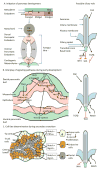Primary cilia in pancreatic development and disease
- PMID: 24864023
- PMCID: PMC4213238
- DOI: 10.1002/bdrc.21063
Primary cilia in pancreatic development and disease
Abstract
Primary cilia and their anchoring basal bodies are important regulators of a growing list of signaling pathways. Consequently, dysfunction in proteins associated with these structures results in perturbation of the development and function of a spectrum of tissue and cell types. Here, we review the role of cilia in mediating the development and function of the pancreas. We focus on ciliary regulation of major pathways involved in pancreatic development, including Shh, Wnt, TGF-β, Notch, and fibroblast growth factor. We also discuss pancreatic phenotypes associated with ciliary dysfunction, including pancreatic cysts and defects in glucose homeostasis, and explore the potential role of cilia in such defects.
Keywords: FGF; Notch; Shh; TGF-beta; Wnt; cilia; ciliopathies; development; glucose homeostasis; pancreas; pancreatic cysts.
Copyright © 2014 Wiley Periodicals, Inc.
Conflict of interest statement
Conflict of Interest: The authors have no conflicts of interest to declare
Figures

Similar articles
-
Primary cilia deletion in pancreatic epithelial cells results in cyst formation and pancreatitis.Gastroenterology. 2006 Dec;131(6):1856-69. doi: 10.1053/j.gastro.2006.10.050. Epub 2006 Oct 26. Gastroenterology. 2006. PMID: 17123526
-
Role of cilia in normal pancreas function and in diseased states.Birth Defects Res C Embryo Today. 2014 Jun;102(2):126-38. doi: 10.1002/bdrc.21064. Epub 2014 May 26. Birth Defects Res C Embryo Today. 2014. PMID: 24861006 Review.
-
Cellular signalling by primary cilia in development, organ function and disease.Nat Rev Nephrol. 2019 Apr;15(4):199-219. doi: 10.1038/s41581-019-0116-9. Nat Rev Nephrol. 2019. PMID: 30733609 Free PMC article. Review.
-
Cilia signaling and obesity.Semin Cell Dev Biol. 2021 Feb;110:43-50. doi: 10.1016/j.semcdb.2020.05.006. Epub 2020 May 25. Semin Cell Dev Biol. 2021. PMID: 32466971 Free PMC article. Review.
-
Cauli: a mouse strain with an Ift140 mutation that results in a skeletal ciliopathy modelling Jeune syndrome.PLoS Genet. 2013 Aug;9(8):e1003746. doi: 10.1371/journal.pgen.1003746. Epub 2013 Aug 29. PLoS Genet. 2013. PMID: 24009529 Free PMC article.
Cited by
-
Ciliogenesis and Hedgehog signalling are suppressed downstream of KRAS during acinar-ductal metaplasia in mouse.Dis Model Mech. 2020 Jul 30;13(7):dmm044289. doi: 10.1242/dmm.044289. Dis Model Mech. 2020. PMID: 32571902 Free PMC article.
-
Feline Adipose Derived Multipotent Stromal Cell Transdifferentiation Into Functional Insulin Producing Cell Clusters.Front Bioeng Biotechnol. 2022 Jun 8;10:904519. doi: 10.3389/fbioe.2022.904519. eCollection 2022. Front Bioeng Biotechnol. 2022. PMID: 35769100 Free PMC article.
-
Potential Roles of O-GlcNAcylation in Primary Cilia- Mediated Energy Metabolism.Biomolecules. 2020 Nov 1;10(11):1504. doi: 10.3390/biom10111504. Biomolecules. 2020. PMID: 33139642 Free PMC article. Review.
-
An imazamox-based herbicide causes apoptotic changes in rat liver and pancreas.Toxicol Rep. 2018 Nov 19;6:42-50. doi: 10.1016/j.toxrep.2018.11.008. eCollection 2019. Toxicol Rep. 2018. PMID: 30560060 Free PMC article.
-
The Role of the α Cell in the Pathogenesis of Diabetes: A World beyond the Mirror.Int J Mol Sci. 2021 Sep 1;22(17):9504. doi: 10.3390/ijms22179504. Int J Mol Sci. 2021. PMID: 34502413 Free PMC article. Review.
References
-
- Ait-Lounis A, Baas D, Barras E, et al. Novel function of the ciliogenic transcription factor RFX3 in development of the endocrine pancreas. Diabetes. 2007;56:950–959. - PubMed
-
- Altaba ARI. Gli proteins encode context-dependent positive and negative functions: implications for development and disease. Development. 1999;126:3205–3216. - PubMed
-
- Andralojc KM, Mercalli A, Nowak KW, et al. Ghrelin-producing epsilon cells in the developing and adult human pancreas. Diabetologia. 2009;52:486–493. - PubMed
Publication types
MeSH terms
Grants and funding
LinkOut - more resources
Full Text Sources
Other Literature Sources

